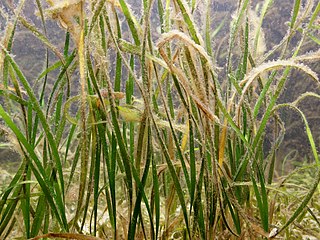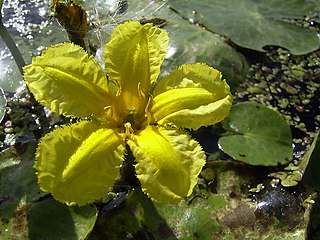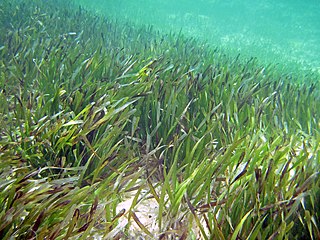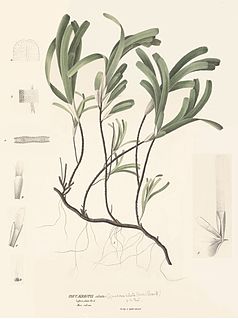
Seagrasses are the only flowering plants which grow in marine environments. There are about 60 species of fully marine seagrasses which belong to four families, all in the order Alismatales. Seagrasses evolved from terrestrial plants which recolonised the ocean 70 to 100 million years ago.

A seagrass meadow or seagrass bed is an underwater ecosystem formed by seagrasses. Seagrasses are marine (saltwater) plants found in shallow coastal waters and in the brackish waters of estuaries. Seagrasses are flowering plants with stems and long green, grass-like leaves. They produce seeds and pollen and have roots and rhizomes which anchor them in seafloor sand.

Cymodoceaceae is a family of flowering plants, sometimes known as the "manatee-grass family", which includes only marine species.
Plant reproduction is the production of new offspring in plants, which can be accomplished by sexual or asexual reproduction. Sexual reproduction produces offspring by the fusion of gametes, resulting in offspring genetically different from the parent or parents. Asexual reproduction produces new individuals without the fusion of gametes, clonal plants that are genetically identical to the parent plants and each other, unless mutations occur.

Phyllospadix scouleri, or Scouler's surfgrass, is a flowering marine plant in the family Zosteraceae. It is native to the coastline of western North America from the Alaskan panhandle to Baja California.

Halophila johnsonii, or Johnson's seagrass, is a small, asexual seagrass in the family Hydrocharitaceae. It occurs only on the southeastern coast of Florida, and was the first marine plant listed on the United States endangered species list, where it is listed as a threatened species. Female flowers have been observed, but even with decade long observational studies, neither male flowers nor seed have ever been observed.

Nymphoides peltata is perennial, rooted aquatic plant with floating leaves of the family Menyanthaceae.

Posidonia australis is a species of seagrass that occurs in the southern waters of Australia. It is sometimes referred to as fibreball weed. It forms large meadows important to environmental conservation. Balls of decomposing detritus from the foliage are found along nearby shore-lines.

Phyllospadix, surfgrass, is a genus of seagrass, a flowering plant in the family Zosteraceae, described as a genus in 1840. Phyllospadix grows in marine waters along the coasts of the temperate North Pacific.

Thalassia is a marine seagrass genus comprising two known species.

Thalassia testudinum, commonly known as turtlegrass, is a species of marine seagrass. It forms meadows in shallow sandy or muddy locations in the Caribbean Sea and the Gulf of Mexico. Turtle grass and other seagrasses form meadows which are important habitats and feeding grounds. The grass is eaten by turtles and herbivorous fish, supports many epiphytes, and provides habitat for juvenile fish and many invertebrate taxa.

Zostera marina is a flowering vascular plant species as one of many kinds of seagrass, with this species known primarily by the English name of eelgrass with seawrack much less used, and refers to the plant after breaking loose from the submerged wetland soil, and drifting free with ocean current and waves to a coast seashore. It is a saline soft-sediment submerged plant native to marine environments on the coastlines of northern latitudes from subtropical to subpolar regions of North America and Eurasia.

Cymodocea nodosa is a species of seagrass in the family Cymodoceaceae and is sometimes known as little Neptune grass. As a seagrass, it is restricted to growing underwater and is found in shallow parts of the Mediterranean Sea and certain adjoining areas of the Atlantic Ocean.

Blue carbon is carbon sequestration by the world's oceanic and coastal ecosystems, mostly by algae, seagrasses, macroalgae, mangroves, salt marshes and other plants in coastal wetlands. This occurs through plant growth and the accumulation and burial of organic matter in the soil. Because oceans cover 70% of the planet, ocean ecosystem restoration has the greatest blue carbon development potential. Research is ongoing, but in some cases it has been found that these types of ecosystems remove far more carbon than terrestrial forests, and store it for millennia.

Zostera noltii is a species of seagrass known by the common name dwarf eelgrass. It is found in shallow coastal waters in north western Europe, the Mediterranean Sea, Black Sea, Caspian Sea and Aral Sea and on islands in the Atlantic off the coast of northwest Africa. It is an important part of the intertidal and shallow subtidal ecosystems of estuaries, bays and lagoons.

Halodule uninervis is a species of seagrass in the family Cymodoceaceae. It is native to the western Pacific and Indian Oceans. Common names include narrowleaf seagrass in English and a'shab bahriya in Arabic.

Thalassodendron ciliatum, the sickle-leaved cymodocea, is a species of plant in the Thalassodendron genus of seagrasses in the family Cymodoceaceae.
Zostera novazelandica Setchell is a species of seagrass in the family Zosteraceae found on the shores of New Zealand. It is regarded as a distinct species by some authors but considered as a synonym of Zostera muelleri Irmisch ex Ascherson by others. The Maori names for Zostera novazelandica are karepō, nana, rehia, and rimurehia.
Zostera muelleri is a southern hemisphere temperate species of seagrass native to the seacoasts of South Australia, Victoria and Tasmania. and New Zealand. Today, Zostera muelleri can be found in regions of Australia, New Zealand, and Papua New Guinea, as well as areas of the eastern Indian Ocean, and the southwest and western central Pacific Ocean. Zostera muelleri is a marine angiosperm, and is commonly referred to as eelgrass or garweed. It is a fast growing and readily colonizing species that serves as a feeding ground for wading birds and aquatic animals, and a breeding ground for juvenile fish and shrimp species.

Syringodium isoetifolium, commonly known as noodle seagrass, is a species of flowering plant in the family Cymodoceaceae, growing underwater in marine habitats. It forms seagrass meadows in shallow sandy or muddy locations in the Indian and Pacific Oceans.

















